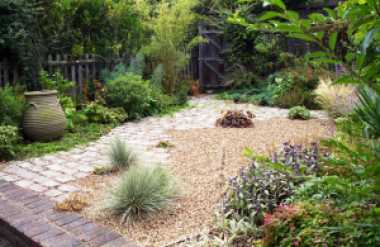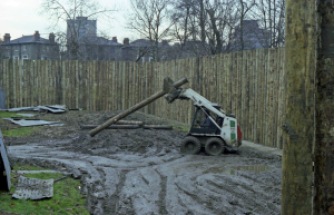-
Suffering from Allergies?
Ann and I were fortunate to interview Tom Ogren.
Tom is the author of a fascinating ,very informative book about Allergies in the garden.
This is a must read for avid gardeners everywhere. Especially if you are one of the many suffering from allergies.
You can hear our interview with Tom below or at www.growingtrends.org or on iTunes at Growing Trends
We would love to hear your thoughts and comments, please spend a moment sending us your thoughts and suggestions.
Ann & Chris
Podcast: Play in new window | Download
Subscribe: RSS
Views: 281
-
Creating mystery & intrigue with Timber Walls, Fences & Trelliage
Last time we talked about paths.
Today I thought it might be advantageous to discuss ‘Timber Walls & Fences’.
We will include Trelliage as they all have a role to play.
Helping to create a certain kind of mystery within a garden landscape.
We’ve discussed hedges recently, so you can scroll down to that article if you would like.
These ‘vertical materials’ are acting as a visual or physical barrier between differing areas.
This leads the eye on to a new discovery or perhaps just creating an interesting space.
At some time fairly soon we should add ‘Green Walls’ which are gaining in interest and can look absolutely superb.
I wonder how long it is before we develop these to grow vertical edibles ?
Having designed and built a huge number of gardens over the years. We have gained valuable experience in what works best in a given situation.
Using Timber.
The garden below, was primarily designed to reduce aftercare. Taking care to keep the beautifully rustic boundary fencing, which blends in to both the surroundings and the new work so well.
It was necessary, to repair the odd arris rail, a couple of fence posts and some slats, re-hang the side gate etc. Overall by keeping the original fence the rustic feel was, I think, you will agree maintained.

Low hit and miss side fence with 6ft feather edged boundary fence & framed gate Start with what is already there.
It’s nearly always best to work with what is already there, rather than ripping out everything. My first task is always to look up and see how the tree canopy is. Then beyond the space we are working with.
To see what impact, we may be making without perhaps realizing how a neighbor might view our endeavors.

Very low maintenance, Mediterranean style In small gardens complete barriers tend to make the garden smaller. It is best to create more of an illusion of a barrier. This is often best created by using trellis. Here is an example that we stained black.
A word of warning, trying to make a gate from trellis is fraught with problems if you do not add a full frame that is braced. When you add this, it tends to upset the look of the trellis, so think carefully before using as a gate. As without the frame the gate will change shape over time!
Trelliage
The trellis here was primarily to separate the more formal ‘Front Garden’ with the more relaxed ‘Play Garden’ at the rear and side of the property.
To improve the strength of this gate we added metal framing at each corner, both inside and outside, it was only partially successful.

A black stained trellis gate If a more substantial barrier is required, say in the form of a structural wall to hold back a bank then there are a number of ways to achieve this.
Low Timber Retaining wall.
Here we used vertically set timber as a retaining wall. We did place a waterproof membrane behind the timber and a gravel pressure release drain. So as not to have unsightly stains running across the light colored paving.

Low timber retaining wall A quite pleasing effect can be achieved.

The softer low timber wall looks at home here. Roof Gardens
Roof gardens benefit from the light weight of timber. Its ability to be ‘modulised’, as can be seen here.

Low timber walls on roof garden Structural Timber Walls
Some years ago, now, we discovered. Well perhaps I should say a local native of our area wanted someone to test a new product he had found lurking in New Zealand. So, as we had won a number of awards for our work, and our teams were well known, he persuaded us to try this product.

Structural Timber Walls It was fantastic. Ok I should add some provisos, it is treated wood, it lasts a very long time, I have pieces from 30 years ago that are still unblemished. Maybe bleached a little but otherwise fine. It will twist if not constructed correctly, although it is unzippable and thus fairly straightforward to repair. If you introduce plants into the wall, it looks amazing. Infact the plants protect the timber.
Here’s a much taller one we completed.
It is essential to use a structural engineer to carry out the necessary survey, and calculate the design criteria for these ‘Gravity Walls.’
Once established they can look like this..

Planting covering a timber wall 
The timber wall blends in so well Some years back we were even asked to build a play area within a timber stockade. The posts were about 16 ft long and required some ingenuity to place correctly.

Treated timber barrier in play area Here’s how we did it..

Using a 4in1 bucket on a bobcat Moving to more decorative uses, let’s explore trelliage and low walls..

Wishing well feature with trellis back drop We sometimes add some whimsy to our designs. Here we used a rather deep drainage shaft, disguising it as a wishing well. To make it stand out we added a trellis surround to enable us to plant climbers to enhance the visual impact. Here its just been completed.

Pergola with Wishing Well at end of path Ornamental Trelliage
Here we used a cloud trellis to add some movement to the landscape. To help hide the boring stepped trellis in the neighboring garden.

Cloud trellis adds movement Here the trellis has been painted white next to the house it gives a very clean look.

Painting trellis white adds interest Here we had a custom-made heavy-duty trellis, note the pencil edges soften the whole fence.

Superb detail for trellis 
The completed trellis barrier Ann & I will spend a little time on the radio show talking about materials. When we interview our next guests who will be Designers.
In the meantime, do come and listen at Growing Trends
We would love to hear from you with ideas, comments, suggestions and requests…
Ann & Chris
Views: 323
-
What one item or feature is the most important in a garden landscape today ?
So a question ?
What one item or feature would you add to your or your clients garden today?
When we started out with our then new company back in 1984, we identified “designer drives”, especially drives with an ‘In & Out’ drives as the most important. Sure enough within 6 months our order book stretched out into the following year.
The first drive we built in the then traditional way, hardcore sub base, with natural frost proof bricks laid on wet mortar and then pointed with a stiff one to three pointing mix – it took ten days!

Then we remembered a new dry-lay product we had used when we worked in the parks department, it had been designed for bus stops. Called ‘monolok’ it was a ‘z’ shaped concrete block.
We called Marshalls the manufacturer who dispatched a sales rep with a new rectangular version, available in grey and off red only … we loved the product but were not over enthusiastic about the colors.

Other firms descended on us for information, our advertising, which showed sporty cars sitting on interlocking concrete block and brick paving, produced lots of interest.
It wasn’t long before the manufacturers were calling wanting to take pictures of our drives. Which they used in their advertising material.
An example of a brick drive
Here we used stock brick paving. Although fairly soft, with somewhat irregular shapes, requiring much shorter modules, it keeps its color very well.

45 degree herringbone 
Here a much harder engineering quality natural brick is used to good effect. Although to be honest it looks a little ‘hard’

Dri-lay natural brick drive The next was concrete block paving, these were very hard, initially with limited colors. The color does fade quite quickly. They are also quite slippery in the ice.
Some of my favorite materials to use.
As our order book enlarged we started offering more expensive solutions, such as granite setts – something the Romans introduced.

This granite sett pathway is extremely hard wearing and yet very rustic looking. These drives are very hard wearing, color fast, strong, again a little slippery in ice.

It wasn’t long before we included ‘Fish scale’ versions, these took quite a long time to set out, but looked absolutely amazing when completed.

Laying small unit sett paving of almost random size in a radiating pattern requires skill and patience…. Then these circular natural sett patterns became popular. The radial patterns create a strong a sense of movement – just look at them long enough, they seem to ‘move’
What new trend, item or feature do you think will be the favorite for 2020?
We will interview the top three on our radio show Growingtrends.org during the year.
Just drop us a line with your suggestions..
Views: 313
-
Privacy Planting a Garden Hedge
Garden Hedges,
Hedges are often used to create a boundary between sections of gardens. They can help lead you around a garden. Although often their primary role is to act as a privacy barrier. A hedge can be a very useful garden tool.
Personally, we’ve even used ones for security. BY choosing a suitably thorny subject, it can make it impossible for someone or something to get through the branches.
The picture below, shows a hedge being used as an entrance into a garden, creating some privacy and yet leading the eye to the main terrace doors.
A hedge can be grown using almost any plant material that will withstand constant clipping. The list of suitable plants is quite large. At the smaller end you have the traditional box hedging often used in kitchen gardens, or to surround ornamental flower beds, as seen below.
Types of Plants to use.
To create a less formal barrier, you could use forsythia – but remember that forsythia flowers on last year’s wood. So pruning and shaping should be restricted to just after flowering if possible. Hornbeam, Beech, Rose, Escallonia, Cotoneaster, Laurel, Yew, Leylandii, Thuja all make a nice hedge.

Of course the height you desire the hedge, makes a difference in choice of plants to use as well.
Heights of hedges.
The height is also dictated by how often and by what method is used to keep the hedge clipped. As can be seen below, this hedge would take many hours of work to keep it in this condition.
Trimming a hedge can be a simple job, with a handheld trimmer or a more serious project with lots big of equipment.


Clearing away the cuttings Views: 348
-
How it all began……..
Beautiful landscapes take time, professionalism & commitment, from the owner, the designer, the builder and the maintainer.
Unlike almost any other purchase a homeowner can make, an external project involves nature, nature has a habit of seeking attention often !
So let’s take a moment to walk into my life as they say.
There is a well known expression ” The customer is always right” – this is very true. It is essential to build the customers trust, and not lose it, for once gone events have a habit of sending everything as we say ‘Pear shaped’ …. today, let’s stay positive and explore some experiences….
I only know ‘My’ experience, which to be fair has been fairly extensive, as well as fun, over all very enjoyable, with the odd heart stopping moment, which we will discuss later.
My school days, yes ,I was privileged, were at Bearwood College, it’s a school in a beautifully laid out estate. Designed by The Rev Gilpin back in the early 1800’s for John Walters the founder of ‘The Times’, – some 500 acres, at school we were expected to do Estate work on the huge grounds once a week to help maintain the appearance of the school around the mansion house.
So as a youngster for 2 hours every week we played at aftercare of a huge Estate – I’ve just interviewed a colleague who did this for real as a Head Gardener of a 12000 acre estate, with among other things a 44 acre formal garden, this after years of designing spectacular award winning gardens, it’s a fascinating interview, as the estate is probably the busiest in the world with many events attracting over 100,000 visitors at a time, there is a motor racing and horse racing circuit within the grounds ! – you can hear Alan shortly on Growing Trends Podcast
During my vacations to earn additional pocket money for school – the Tuck Shop was stocked with all things fattening, that us kiddies always preferred to real food ! No just kidding.
I worked with a friend in his dad’s business of Forestry – we planted new woodlands in the winter break, did more planting in the spring break, then weeded the newly planted woodlands with a long handled hook in the summer break – it was heavy work but very rewarding, the ploughman’s lunch with a pint of shandy at lunchtime sitting out in a pub garden in the summer was glorious, however toasting your homemade sandwiches over a small twig fire in the depths of winter, cold, soaking wet, drinking peppered hot bovril wasn’t quite the same, especially as your toes were on the verge of frostbite !
Even the summer days had their own special moments…
“That is until you came across a wasp’s nest buried in the ground in your row as you cut down the foxgloves, brambles, and other assorted weeds a swarm of angry wasp’s chased you along your row, which I might add was almost always a vertical hillside ! The really scary one was, when a pheasant launched itself at you as you almost chopped its head off ! It used to take me a few minutes to calm down from that – you never ever hit the bird, or really saw it, but you sure heard it, and it was a huge blur as it flew past you.!”
After leaving school, working for a year at an Estate Agent’s introducing clients to property investments, helping sell houses and commercial properties all around the Thames valley.
I heard about a new landscape course at Merrist Wood College, was accepted, and spent three years really enjoying myself earning a College Degree in the process !
The course was so good, everyone of us was head hunted way before the course finished, well, now that I come to remember Bill, he had the new MGB sportscar, decided to buy a yacht and sailed off into the yonder, never to be heard of again !
Subsequently I discovered how much fun it is to have a yacht and go sailing !
I spend a further three or four years in a London Borough’s parks department learning some serious construction techniques – they called us Landscape technicians. There were six of us, in the group, when four of us left and the fifth joined the ranks of the clergy, one of the original six is still there so Ian must have 43 years of service ! It took almost 12 full time jobs to replace us !
We learned a huge amount, it was a great place to learn, with lots of variety, seriously engineered construction techniques, a dedicated to us work study team, so we knew how long items took to build.
Overall though it lacked the ability to really expand ones horizons, beyond parks, open spaces & schools, so after three years it was time to move on.
Private practice was a completely different place, armed with the knowledge of how to build to an exacting commercial standard – something that held us in very good stead as we built our company, we did something probably unique at that time, we deliberately concentrated on Design and Build we won one award after another, ( currently 17).
We achieved this mainly because we created a standard working method, for our staff, we used standard details that we documented,. Most importantly we loved to experiment with new ideas.
No we didn’t do this ! This is a planning ‘item’ in Oxford, but I bet you took a couple of looks at it !
One of the first A-ha !!! moments was Dri-lay drives, it happened because a client asked for a brick drive with a dark mortar joint.
We duly designed and installed the drive – which took two men 10 days just to point by hand !. This seemed a waste of potential profit , so recalling our local authority days the next one we tried was with the dri-lay method we had used in parks, the very first project saved us over 50% of the normal time to complete !
One of the design features we added, was a ‘canted’ brick edge, when ever possible this served two purposes, it was visually very attractive, catching the eye, creating a visual movement.
More importantly for the housewife, it was a superb aide memoir when driving onto as if you got too close to the edge the powered steering ‘tweaked’ enough to prevent you from driving into the landscape – this produced lots of customers from recommendations..
Below you see the first ‘dri-lay’ natural brick drive, we used a harder brick at first as the clay bricks tended to snap if you applied too heavy a vibration – after a while we figured using a rubberised mat would alleviate this issue.
The bonus to us, the first drive took 2 weeks to complete, this one was finished inside 4 days !
I well remember driving to a large concrete manufacturer of paving and blocks in 1984 and asking for help with our advertising budget – in those days the firms would pay a percentage of your advertising if you mentioned them. Anyway we went up to Derby from London ! gave a presentation on ‘Designer Drives” , it blew them away and we were politely told that the market didn’t exist. – a year later we had 5 crews constantly working building Dry lay drives, so many firms were starting to see the market potential. that we moved up to bricks.
By then we offered Block Drives, Brick Drives and for the really discerning Granite Sett drives – I have to say a granite sett drive looks quite exceptional
We also learned a valuable lesson, as we didn’t want to just build drives, we broadened what we offered clients, adding canted brick edges, specially designed recessed manhole covers, multi coloured drives- which then became ‘brindled.’ As the manufacturers caught on.
Pictures of our drives appeared on advertising brochures from those very companies.
Our next Aha !!! moment was the recessed manhole cover, which we made ourselves at first..
See if you can see the second one in this picture above! This project was one of the first where we used a specially made stock brick the yellow is the kiln dried sand we used to brush between the interstices.
and the final result ..
We designed & built lots and lots of drives…100’s of 1000’s of square meters in area.
We learned some valuable time saving lessons, the best looking was always bricks laid 45 degrees from the road direction, they took longer and required much more cutting, so warranted a slightly higher charge, but they almost always looked better.
Natural bricks are not a standard size, so after about 6 ft (1.8m ) of one direction the joints tend to start running out of line so be careful how you set out. Oddly 45 degree herringbone actually helps to hide this visual effect.
I have to admit that it has, and continues to be, an awful lot of fun and enjoyment, not to mention the satisfaction that comes from achieving a well thought out and attractive scheme, or seeing a client years later saying how much they have enjoyed what was done, how well it has lasted.
A case of “Quality is remembered long after the price has been paid.”
I’ve always adopted a slightly different approach with private clients as I felt that most were not highly conversant with contractual law, or quantity surveying, always striving to give sound , honest advice, and maintain a high quality finish no matter what….
How is it that some projects just look wonderful and others just ok ?
The answer is in the detail and the finish.
There is also no doubt in my mind that, the more experience one has, the greater the ability to be able to produce , not only an award winning scheme, but also to ensure that the design is both workable and economically viable – of course if money is no object ? – I have personally worked on a few projects where money was not part of the equation, oddly they didn’t work out any better than a well designed and thoughtfully implemented scheme.
Some more A-ha !!! moments later , especially as we have grown longer in the tooth, we become smarter and now obtain patents for our “A-ha !! ” moments.
In the meantime do listen to our interviews at Growing Trends
Drop me a line if you have a question or request.
Chris
Views: 125
-
Journey to Dreamtime

The professor takes Sophie, Dylan and their two pets Monty and Naomi on a wild adventure I’ve been writing this blog for a few years now, in addition with my wonderful co-host Ann we have been interviewing the fascinating people we find for our podcast www.growingtrends.org
Last year I was asked if we might develop a learning aid for children based on how we grow food, develop sustainable approaches to agriculture and cope with modern city life. I agreed because I felt we do need to help this planet of ours every so often.
After much thinking coupled with the odd glass of wine – I’m fairly partial to a nice burgundy. This along with late night chats with friends and my lovely wife the small light bulb ( well it has to be an LED these days) began to flicker.
“Why not make the learning an adventure story?”
Journey to Dreamtime was born, currently available as an eBook it will soon be available as a paperback, you can see more here…www.journeytodreamtime.com
Now available in a paperback, you can order either on Amazon or from BookLocker
Please do let me know what you think…. book two is going to be based in America.
Thank you.
Views: 50
-
The Cancer Survivor’s Garden Companion

Ann and I were fortunate to interview Jenny Peterson, just after her new book was published. Jenny is an amazing, extremely positive lady who is an inspiration for us all.
A Garden that Heals.
Pittsburgh, Pa. (October 5, 2015): When Jenny Peterson was diagnosed with breast cancer in 2012, it rocked her world. Her cancer treatment was hard, emotional and often deeply depressing. But Peterson, a garden designer and Master Gardener, did not let the cancer diagnosis define her. She used her desire to garden and dig in the dirt again to pull her out of the darkness. And she discovered that gardening is good medicine –for the body, mind and spirit.
The Cancer Survivor’s Garden Companion:
Cultivating Hope, Healing and Joy in the Ground Beneath Your Feet
(St. Lynn’s Press, January 2016) tells Peterson’s story and explores the therapeutic benefits of this vital “earth connection,” including inspirational profiles of other cancer survivors, both men and women, whose gardens became their partners in healing.With gentle empathy, beautiful photographs and easy how-to steps. Peterson shows others how to create their own backyard haven for healing – a personal restorative garden – with well-grounded guidance about diet, exercise, mental focus and spiritual renewal. Her book adds a fresh voice to the growing fields of horticultural therapy and therapeutic gardens.
What others are saying about The Cancer Survivor’s Garden Companion:
“Jenny’s tips for incorporating gardening into your life for mind, body, and spiritual health are ingenious!
What other authors are saying.
As a cancer coach, I will definitely be suggesting this book to my clients.” – Susan Gonzalez, BSN, CPCC, co-author of 100 Perks of Having Cancer Plus 100 Health Tips for Surviving It, and editor of The Savvy Sister blog
“Jenny’s beautiful book reminds us all that life can be found in the healing, meditative act of gardening. By lovingly tending a garden, we can learn to nurture ourselves, restoring our mind, body and spirit in the process.” – Ray Anne Evans, Executive Director, Breast Cancer Resource Centers of Texas
“Jenny’s connection with gardening, garden design, and simply being in nature remained strong throughout her cancer diagnosis, treatment, and recovery. In fact, it was part of what helped her through. And now she is helping others to learn from her powerful experience.” – Naomi A. Sachs, Founding Director, Therapeutic Landscapes Network; co-author, Therapeutic Landscapes: An Evidence-Based Approach to Designing Healing Gardens and Restorative Outdoor Spaces
The Cancer Survivor’s Garden Companion will teach readers how to use the garden to heal, find hope and feel joy.
About the Author.
Jenny Peterson is a landscape designer and Master Gardener specializing in xeriscaping and small urban spaces. She is a cancer survivor who found hope and healing in her garden, even during the darkest days of chemotherapy and radiation. In the process, she made deep connections with the cancer support community, including physicians, nutritionists, bodywork practitioners, psychologists and spiritual counselors.
Peterson co-authored Indoor Plant Décor: The Design Stylebook for Houseplants (St. Lynn’s Press, 2013) with Kylee Baumle. She lives in Austin, Texas, with her fiancé, 19 chickens, two dogs, two quails and a goat.
You can listen to the interview here : Interviewing Jenny Peterson
If you would like to purchase the book : The Cancer Survivors Garden Companion
Podcast: Play in new window | Download
Subscribe: RSS
Views: 146
-
The right-sized Flower Garden
Kerry Mendez has a passion for gardening, in her latest book “The right-sized Flower Garden” she discusses how to develop a garden that you can manage, often this will reduce the amount of work involved. As she explains it’s all … Continue reading
Podcast: Play in new window | Download
Subscribe: RSS
Views: 79
-
Growing Trends interviews Bill Sosinsky on his recent trip to China
Hello everyone, we hope you like our new logo ?
We have some great interviews planned for the next few months.
Our first is with Bill Sosinsky , CEO of Energime University. Bill has recently returned from a trip to China. He talks to us about how the Chinese are adapting, planning and coping with the enormous growth the country has seen over the past few years.
Cities of 5 – 10 million people built in under 10 years !
This type of growth brings staggering infrastructure issues or as Bill says ” This is a big deal !”
The interview is one of those must listen to events… we all have seen or heard of the Great Wall of China, a quite amazing feat of building, as seen here.
I wonder how many of us can comprehend the current building program?
100 million homes in the next 5- 10 years…!
That’s almost one third of the total housing in the USA
Truly a monumental task of ingenuity, engineering and collaboration, Ann and I were just amazed talking to Bill about the growing issues they are trying to solve.
We will have two parts to this fascinating interview you can listen to the first part here….
We would love to hear from you with ideas or suggestions on programs, either fill in the form below or just send us an email to info@grotrends.com
Ann & Chris
Podcast: Play in new window | Download
Subscribe: RSS
Views: 102
-
If I were opening a Garden center today
Garden Centers have evolved over the years, there are Independent Garden Centers often in a local neighborhood, there are larger groups with multiple locations.
Many of the big box ‘Do it Yourself stores’ have larger and larger ‘Garden Center’ sections.
The question recently has been where are they all heading.
So Ann asked Sid & John – “If I were to open a Garden Center today what would be your recommendations?”
Sid Raisch
CEO of Horticultural Advantage (www.AdvantageDevelopmentSystem.com) , providing business expertise and extensive leadership training to small to medium horticultural businesses, primarily retail garden centers and selected wholesale suppliers.
John Stanley.
International retail guru is what people call me. Specialising in helping retail businesses to grow their bottom line and expand their market base. I work in 26 countries with retailers of all sizes. My expertise ranges from conference speaking to hands on management consultancy. My specialist retail areas are in perishable retailing – anything that will not last long without loving care on the shelf
Sid and John discuss future trends for gardens, garden centers, and our urban environment.
This fascinating , very informative interview is going to have you thinking.
Send us your thoughts to Growing Trends
Podcast: Play in new window | Download
Subscribe: RSS
Views: 100
-
Ann visits the Chelsea Physic garden
It’s not often you find a garden that was founded in 1673 as The Apothecaries’ Garden
Ann was on a trip to Europe recently and dropped in on the beautiful Chelsea Physic Garden on the side of the river Thames in London.
The garden’s purpose was to train apprentices in identifying plants. The gardens’ location close to the river created a warmer microclimate, significantly increasing the many non-native plants that could be grown.
In 1700 the garden had started an international botanical garden seed exchange system, which continues to this day.
The gardens cover some four acres and are leased on what is known as a peppercorn rent in perpetuity.
They are without doubt one of London’s secret ‘gems’ and thoroughly worth a visit.
The garden’s mission ” Linking people with plants and nature”
The interview starts with Ann talking for around 8 minutes to a group of school children on a field trip, the gardens have over 100 such visits a year. Ann then talks to Michael a very knowledgeable and extremely helpful member of staff. We kept all the typical inner city sounds on the recording – the enthusiasm of the children is very heartening.
Integrated pest management is the preferred method of bug control…
They have a project called “Shelf Life’ it is just an incredible way to show children where their food comes from
You can also listen to Ann’s interview on iTunes at Growing Trends
We would love to hear your comments and suggestions for a show… just send us an email to Growing Trends
Podcast: Play in new window | Download
Subscribe: RSS
Views: 88
-
Growing Trends : How we look at Food Tourism today
Ann and I interviewed John Stanley of John Stanley Associates recently about his new book, he jointly wrote with his wife Linda,
Food Tourism – A Practical Marketing Guide.
The fastest growth in tourism today is the culinary sector.
Listen to John as he explains the overall direction of food tourism, including how he sees future development.
A few snip bits:
Do you grow soil?
25% of the food we buy comes from 2% of the farmland around our cities, which is being swallowed up by development.
Farmers used to make 38 cents on every dollar now its down to an average of just 6 cents
Eating local seasonal food saves you around 25%, and is actually healthier for you!
You can hear this really informative interview here (click below) or on iTunes at Growing Trends
Podcast: Play in new window | Download
Subscribe: RSS
Views: 49

























































